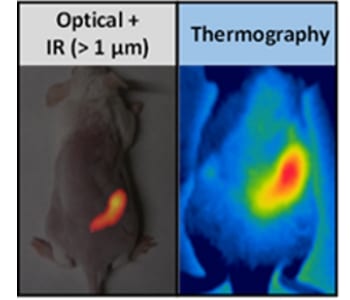 Ultrasmall NdVO4 nanoparticles are developed as a promising agent for deep-tissue photothermal therapy by Daniel Jaque and co-workers. Due to their high neodymium content and small size, the nanoparticles show an excellent light-to-heat conversion at 808 nm irradiation. At this wavelength, the required irradiation can reach the subcutaneously injected nanoparticles with minimal collateral damage.
Ultrasmall NdVO4 nanoparticles are developed as a promising agent for deep-tissue photothermal therapy by Daniel Jaque and co-workers. Due to their high neodymium content and small size, the nanoparticles show an excellent light-to-heat conversion at 808 nm irradiation. At this wavelength, the required irradiation can reach the subcutaneously injected nanoparticles with minimal collateral damage.
Nanoparticle-mediated photothermal therapy is a low-cost, selective cancer therapy tool, which can be combined with radiotherapy and chemotherapy. Nanoparticles are injected into the malignant tissue and heated by irradiation. Thus, the method is limited by the tissue penetration depth of the irradiation due to scattering and absorption.
At the absorption wavelength of NdVO4, 808 nm, the absorption of biological tissue is low, which increases the penetration depth of irradiation and minimizes collateral damage to the tumor-surrounding tissue. An additional advantage of the ultrasmall NdVO4 nanoparticles is that they emit fluorescence in the infrared region. This emission can be used to localize injected nanoparticles and explore tumor progression after photothermal treatment. The NdVO4-nanoparticle-containing tissue can be heated to 50 °C upon irradiation, which is above the required temperature for tumor ablation. This high light-to-heat conversion can be ascribed to the large absorption cross-section of neodymium ions and the fact that the ultrasmall size of the nanoparticles leads to large nonradiative decay rates. Based on their results, the authors propose that neodymium-containing nanoparticles can be an alternative to traditional metallic, organic, or carbon-based photothermal agents. However, their toxicity needs to be further investigated, and the shown properties need to be confirmed by in vivo photothermal cancer therapy experiments.

















